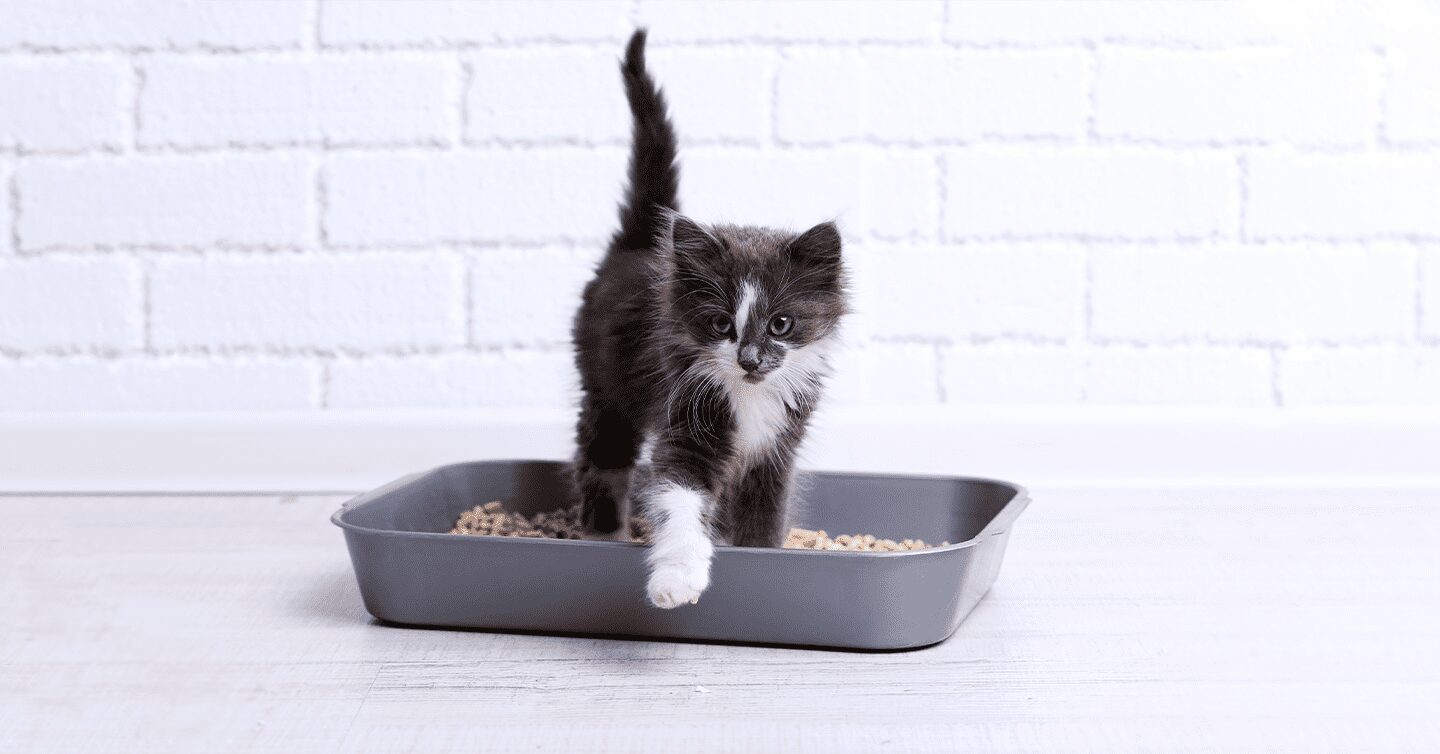So you’ve added a tiny, adorable, four-legged baby to your family – congratulations! Get ready for the joy of seeing your kitten’s firsts – their first meal in their new home, their first time climbing up your steps, and of course, their first time using the litter box!
If you’ve ever tried to potty train anyone, whether it be a human or an animal, you know it’s not a walk in the park. However, new kitten parents should take comfort in learning that litter box training a kitten is actually quite easy.
If you adopted a particularly observant fluffball, your kitten might have picked up on how to use the litter box from watching their momma cat use the kitty restroom. Even if your little nugget didn’t quite pick up on it then, their instincts naturally drive them to conceal any evidence after doing their business. Going potty inside a box is almost second nature to felines, thankfully.
Regardless of how simple it may seem, new and veteran kitten owners alike can always use some extra help. In this article, we’ll provide you with the tips and tricks pet parents need to make house training your kitten a breeze!
Getting started
Before you even bring your kitten home, you should have your cat’s litter boxes all set up. It’s advisable to have one extra litter box to the number of cats in your house. If this is your first and only kitten, you should start off with two. If you already have a cat in the house with two litter boxes, add one more.
Make sure to place litter boxes in spots around the house that make sense. That means placing litter boxes in quiet areas where the kitty can focus on going potty. Also, try to place them in low-traffic areas as constant activity can be very distracting. You wouldn’t want a marching band parading through your bathroom when you’re trying to go. Neither does Snowflake. If you live in a multi-story home, keep at least one litter box on every floor. Your cat should have easy access to a box no matter where they are in the house. Try your best not to move litter boxes around, especially during the potty training process, because it will make it more difficult and confusing for your kitty to know where they need to go. Imagine if your bathroom just up and changed locations. It’d be perplexing, to say the least. It’s also a good idea to place a puppy pee pad under their litter box during the initial potty training process for easier cleanup.
Now let’s get down to the nitty gritty – litter. There’s no shortage of different types of litter, including clumping and non-clumping, scented and unscented, clay litter, silica litter, and even eco-friendly, newspaper-based pellets. Most cat specialists advise against using a clumping litter for kittens because they’re more likely to ingest it, which can be very harmful to your fur baby. Instead, look for a natural cat litter to get your young kitten started on their bathroom journey. When they reach 8 weeks of age, you can switch to a new litter if needed. It’s also best to start off with unscented litter, as some cats dislike strong smells. If you notice your kitten has any objection to the smell or texture of their litter, swap it out for a different litter. There’s a vast array of different litter types to try, so listen to your kitten’s preferences.
In addition to the wide variety of litter types, there are also several options when it comes to the type of litter box you can buy. Most cat owners opt for covered boxes, as they help trap in odors and make for less mess, but those are more suitable for adult cats. Kittens should have a smaller, shallow box with no top. These boxes are less intimidating, easier for kittens to spot, and easier for the kitten to get in and out of. Once they get bigger, you can upgrade to a bigger, covered box if you prefer. Aside from the standard square, plastic litter box, you can also buy a litter box disguised as regular home decor or furniture. You can find litter boxes that look like planters, benches, side tables, and more. Additionally, you can find plenty of cute and colorful litter boxes that actually enhance the beauty of your home. For cat owners willing to spend more, self-cleaning litter boxes are also available.
Now that we’ve covered those essentials, here are some steps to help you successfully potty train your kitten.
1. Familiarize your kitten with their litter boxes right away
Once you bring your kitten home, show them to their litter boxes as soon as possible. Gently place them inside and let them explore! They’ll want to sniff around and examine the box before they feel comfortable getting down to business, so give them plenty of time to get used to their plastic throne. If your kitten is hesitant to get into their box, gently run your fingers through the clean litter to encourage them to start exploring. Bear in mind that most kittens won’t start using a litter box until they reach three weeks of age. Every kitten is different and each one develops at a different pace, so be especially patient while you attempt to potty train.
2. Bring them to their litter box frequently
Pick your kitten up and place them in a litter box immediately after each meal and after they wake up from naps. They’ll most likely have to go during these times and this helps them create a regular bathroom schedule and decrease the likelihood of any messes! Ideally, they should get used to associating the feeling of needing to go to the bathroom with the act of heading over to their litter box.
3. Be aware of your kitten’s “gotta-go” behavior
If you ever see your kitten sniffing around, crouching down, or speeding off to a secluded area in the house, it could be a sign they need to go to the bathroom. If you see this kind of cat behavior, pick them up and put them in their litter box right away. Eventually, you’ll be able to spot these signs more quickly and determine whether or not it means they need to go.
Pet Pro Tip: New kitten owners often underestimate the long-term costs of veterinary care for a pet’s unexpected accidents & illnesses. Make sure you get your kitten insured as soon as possible!
4. Praise for the potty!
Each time your kitten successfully uses their litter box, reward them with a treat, a piece of their food, or a new toy. Positive reinforcement will make them want to continue doing their business in – and only in – their litter box. You’ll need to wean your kitten off of the rewards eventually, but it’s perfectly fine while you’re starting out. Bribing your kitten is a small price to pay for preventing them from having an accident on your carpet. Speaking of which…
5. Don’t punish your kitten for accidents
Accidents happen! If you punish your kitten when they go to the bathroom somewhere other than their litter box, this will just increase the stress and anxiety they feel towards going to the bathroom. This can make potty training even more difficult as they’ll likely start to associate the act of going to the bathroom with being punished, no matter where they do it. If they do have an accident, stay calm and clean up the mess right away, preferably with an enzyme-based cleaner. Sometimes kittens develop habits of going to the bathroom on top of piles of laundry or other clutter on the floor. If you notice yours is frequently doing this, keep your floors clear. As previously mentioned, it’s not a good idea to move your litter boxes around once you’ve set them up, but in some cases this is okay. If your cat is constantly going to the bathroom in the same spot in the house, move a litter box over to that area. This can really help kittens that are struggling to grasp the idea of using the litter box.
6. Keep litter boxes clean
You’ll determine how often you need to clean your kitten’s litter boxes as time goes on, but there are a few habits you should get into when you first get a kitten to make for less hassle (and less stink) in the long run. Get in the habit of scooping up your kitten’s poop or litter clumps right after they go to the bathroom. At the very least, get to scooping two to three times a day. Cleaning the litter tray itself and replacing dirty litter with clean litter is also something you’ll figure out as you and your cat get into a regular routine, but it’s generally common practice to replace litter every two to three weeks. Remember to replace the litter you remove with some fresh litter, even if you only take a few scoops. The depth of the litter should be 2 to 3 inches to give your kitten room to dig around. If you scoop and clean more often, you might not have to replace the litter as much, which saves you kitty litter and money!
Potty training is only part of the package when it comes to owning a kitten. Although it can be messy business, it’s worth it in the long run. Your kitten will appreciate your patience and understanding while training, and you’ll appreciate their willingness to keep their business where it belongs!




